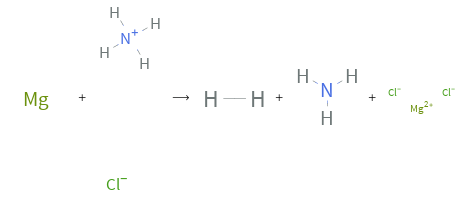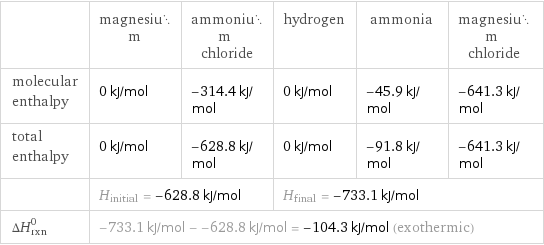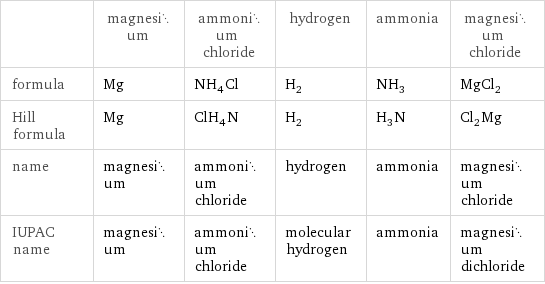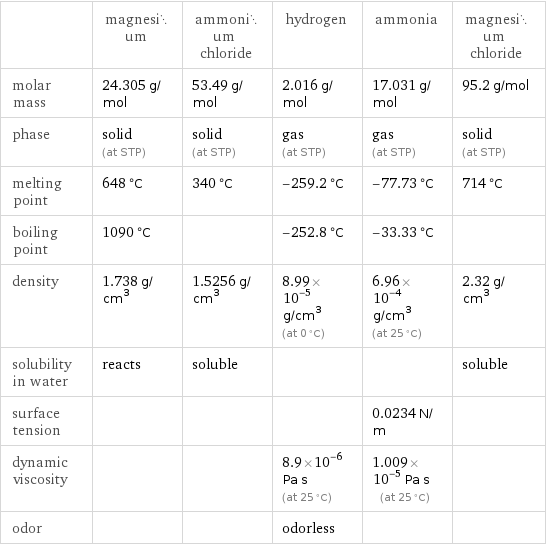Input interpretation

Mg magnesium + NH_4Cl ammonium chloride ⟶ H_2 hydrogen + NH_3 ammonia + MgCl_2 magnesium chloride
Balanced equation

Balance the chemical equation algebraically: Mg + NH_4Cl ⟶ H_2 + NH_3 + MgCl_2 Add stoichiometric coefficients, c_i, to the reactants and products: c_1 Mg + c_2 NH_4Cl ⟶ c_3 H_2 + c_4 NH_3 + c_5 MgCl_2 Set the number of atoms in the reactants equal to the number of atoms in the products for Mg, Cl, H and N: Mg: | c_1 = c_5 Cl: | c_2 = 2 c_5 H: | 4 c_2 = 2 c_3 + 3 c_4 N: | c_2 = c_4 Since the coefficients are relative quantities and underdetermined, choose a coefficient to set arbitrarily. To keep the coefficients small, the arbitrary value is ordinarily one. For instance, set c_1 = 1 and solve the system of equations for the remaining coefficients: c_1 = 1 c_2 = 2 c_3 = 1 c_4 = 2 c_5 = 1 Substitute the coefficients into the chemical reaction to obtain the balanced equation: Answer: | | Mg + 2 NH_4Cl ⟶ H_2 + 2 NH_3 + MgCl_2
Structures

+ ⟶ + +
Names

magnesium + ammonium chloride ⟶ hydrogen + ammonia + magnesium chloride
Reaction thermodynamics
Enthalpy

| magnesium | ammonium chloride | hydrogen | ammonia | magnesium chloride molecular enthalpy | 0 kJ/mol | -314.4 kJ/mol | 0 kJ/mol | -45.9 kJ/mol | -641.3 kJ/mol total enthalpy | 0 kJ/mol | -628.8 kJ/mol | 0 kJ/mol | -91.8 kJ/mol | -641.3 kJ/mol | H_initial = -628.8 kJ/mol | | H_final = -733.1 kJ/mol | | ΔH_rxn^0 | -733.1 kJ/mol - -628.8 kJ/mol = -104.3 kJ/mol (exothermic) | | | |
Equilibrium constant
![Construct the equilibrium constant, K, expression for: Mg + NH_4Cl ⟶ H_2 + NH_3 + MgCl_2 Plan: • Balance the chemical equation. • Determine the stoichiometric numbers. • Assemble the activity expression for each chemical species. • Use the activity expressions to build the equilibrium constant expression. Write the balanced chemical equation: Mg + 2 NH_4Cl ⟶ H_2 + 2 NH_3 + MgCl_2 Assign stoichiometric numbers, ν_i, using the stoichiometric coefficients, c_i, from the balanced chemical equation in the following manner: ν_i = -c_i for reactants and ν_i = c_i for products: chemical species | c_i | ν_i Mg | 1 | -1 NH_4Cl | 2 | -2 H_2 | 1 | 1 NH_3 | 2 | 2 MgCl_2 | 1 | 1 Assemble the activity expressions accounting for the state of matter and ν_i: chemical species | c_i | ν_i | activity expression Mg | 1 | -1 | ([Mg])^(-1) NH_4Cl | 2 | -2 | ([NH4Cl])^(-2) H_2 | 1 | 1 | [H2] NH_3 | 2 | 2 | ([NH3])^2 MgCl_2 | 1 | 1 | [MgCl2] The equilibrium constant symbol in the concentration basis is: K_c Mulitply the activity expressions to arrive at the K_c expression: Answer: | | K_c = ([Mg])^(-1) ([NH4Cl])^(-2) [H2] ([NH3])^2 [MgCl2] = ([H2] ([NH3])^2 [MgCl2])/([Mg] ([NH4Cl])^2)](../image_source/4162c898cb286843756bd99d91879efc.png)
Construct the equilibrium constant, K, expression for: Mg + NH_4Cl ⟶ H_2 + NH_3 + MgCl_2 Plan: • Balance the chemical equation. • Determine the stoichiometric numbers. • Assemble the activity expression for each chemical species. • Use the activity expressions to build the equilibrium constant expression. Write the balanced chemical equation: Mg + 2 NH_4Cl ⟶ H_2 + 2 NH_3 + MgCl_2 Assign stoichiometric numbers, ν_i, using the stoichiometric coefficients, c_i, from the balanced chemical equation in the following manner: ν_i = -c_i for reactants and ν_i = c_i for products: chemical species | c_i | ν_i Mg | 1 | -1 NH_4Cl | 2 | -2 H_2 | 1 | 1 NH_3 | 2 | 2 MgCl_2 | 1 | 1 Assemble the activity expressions accounting for the state of matter and ν_i: chemical species | c_i | ν_i | activity expression Mg | 1 | -1 | ([Mg])^(-1) NH_4Cl | 2 | -2 | ([NH4Cl])^(-2) H_2 | 1 | 1 | [H2] NH_3 | 2 | 2 | ([NH3])^2 MgCl_2 | 1 | 1 | [MgCl2] The equilibrium constant symbol in the concentration basis is: K_c Mulitply the activity expressions to arrive at the K_c expression: Answer: | | K_c = ([Mg])^(-1) ([NH4Cl])^(-2) [H2] ([NH3])^2 [MgCl2] = ([H2] ([NH3])^2 [MgCl2])/([Mg] ([NH4Cl])^2)
Rate of reaction
![Construct the rate of reaction expression for: Mg + NH_4Cl ⟶ H_2 + NH_3 + MgCl_2 Plan: • Balance the chemical equation. • Determine the stoichiometric numbers. • Assemble the rate term for each chemical species. • Write the rate of reaction expression. Write the balanced chemical equation: Mg + 2 NH_4Cl ⟶ H_2 + 2 NH_3 + MgCl_2 Assign stoichiometric numbers, ν_i, using the stoichiometric coefficients, c_i, from the balanced chemical equation in the following manner: ν_i = -c_i for reactants and ν_i = c_i for products: chemical species | c_i | ν_i Mg | 1 | -1 NH_4Cl | 2 | -2 H_2 | 1 | 1 NH_3 | 2 | 2 MgCl_2 | 1 | 1 The rate term for each chemical species, B_i, is 1/ν_i(Δ[B_i])/(Δt) where [B_i] is the amount concentration and t is time: chemical species | c_i | ν_i | rate term Mg | 1 | -1 | -(Δ[Mg])/(Δt) NH_4Cl | 2 | -2 | -1/2 (Δ[NH4Cl])/(Δt) H_2 | 1 | 1 | (Δ[H2])/(Δt) NH_3 | 2 | 2 | 1/2 (Δ[NH3])/(Δt) MgCl_2 | 1 | 1 | (Δ[MgCl2])/(Δt) (for infinitesimal rate of change, replace Δ with d) Set the rate terms equal to each other to arrive at the rate expression: Answer: | | rate = -(Δ[Mg])/(Δt) = -1/2 (Δ[NH4Cl])/(Δt) = (Δ[H2])/(Δt) = 1/2 (Δ[NH3])/(Δt) = (Δ[MgCl2])/(Δt) (assuming constant volume and no accumulation of intermediates or side products)](../image_source/d0cf3e544e74cebee76150b9923302a4.png)
Construct the rate of reaction expression for: Mg + NH_4Cl ⟶ H_2 + NH_3 + MgCl_2 Plan: • Balance the chemical equation. • Determine the stoichiometric numbers. • Assemble the rate term for each chemical species. • Write the rate of reaction expression. Write the balanced chemical equation: Mg + 2 NH_4Cl ⟶ H_2 + 2 NH_3 + MgCl_2 Assign stoichiometric numbers, ν_i, using the stoichiometric coefficients, c_i, from the balanced chemical equation in the following manner: ν_i = -c_i for reactants and ν_i = c_i for products: chemical species | c_i | ν_i Mg | 1 | -1 NH_4Cl | 2 | -2 H_2 | 1 | 1 NH_3 | 2 | 2 MgCl_2 | 1 | 1 The rate term for each chemical species, B_i, is 1/ν_i(Δ[B_i])/(Δt) where [B_i] is the amount concentration and t is time: chemical species | c_i | ν_i | rate term Mg | 1 | -1 | -(Δ[Mg])/(Δt) NH_4Cl | 2 | -2 | -1/2 (Δ[NH4Cl])/(Δt) H_2 | 1 | 1 | (Δ[H2])/(Δt) NH_3 | 2 | 2 | 1/2 (Δ[NH3])/(Δt) MgCl_2 | 1 | 1 | (Δ[MgCl2])/(Δt) (for infinitesimal rate of change, replace Δ with d) Set the rate terms equal to each other to arrive at the rate expression: Answer: | | rate = -(Δ[Mg])/(Δt) = -1/2 (Δ[NH4Cl])/(Δt) = (Δ[H2])/(Δt) = 1/2 (Δ[NH3])/(Δt) = (Δ[MgCl2])/(Δt) (assuming constant volume and no accumulation of intermediates or side products)
Chemical names and formulas

| magnesium | ammonium chloride | hydrogen | ammonia | magnesium chloride formula | Mg | NH_4Cl | H_2 | NH_3 | MgCl_2 Hill formula | Mg | ClH_4N | H_2 | H_3N | Cl_2Mg name | magnesium | ammonium chloride | hydrogen | ammonia | magnesium chloride IUPAC name | magnesium | ammonium chloride | molecular hydrogen | ammonia | magnesium dichloride
Substance properties

| magnesium | ammonium chloride | hydrogen | ammonia | magnesium chloride molar mass | 24.305 g/mol | 53.49 g/mol | 2.016 g/mol | 17.031 g/mol | 95.2 g/mol phase | solid (at STP) | solid (at STP) | gas (at STP) | gas (at STP) | solid (at STP) melting point | 648 °C | 340 °C | -259.2 °C | -77.73 °C | 714 °C boiling point | 1090 °C | | -252.8 °C | -33.33 °C | density | 1.738 g/cm^3 | 1.5256 g/cm^3 | 8.99×10^-5 g/cm^3 (at 0 °C) | 6.96×10^-4 g/cm^3 (at 25 °C) | 2.32 g/cm^3 solubility in water | reacts | soluble | | | soluble surface tension | | | | 0.0234 N/m | dynamic viscosity | | | 8.9×10^-6 Pa s (at 25 °C) | 1.009×10^-5 Pa s (at 25 °C) | odor | | | odorless | |
Units
